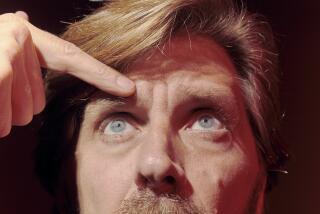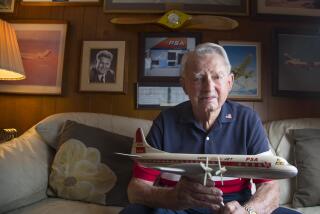Golden Boy : LOSS OF EDEN: A Biography of Charles and Anne Morrow Lindbergh by Joyce Milton , (HarperCollins: $25; 528 pp.)
- Share via
It is almost impossible now, in these days of cheap global air travel, laser-guided weaponry and routine trips to outer space and back, to conjure up the astonishing glamour and fascination of aviation’s early days. Hard too, when thousands of airline pilots are being made redundant around the world, to envisage the aloof, almost superhuman allure of the figure of the aviator.
Part demigods, part daredevils, the first flyers achieved a renown and provoked an awe-struck reverence in the public that now seem almost incredible. These were real men and women who risked their lives in a medium previously closed to human endeavor and in machines that seemed to counter every natural law. And the fact that they were the first truly modern heroes, with the ancient values of fortitude and temerity yoked to the very latest technology the 20th Century could produce, perhaps explains why the mix was so potent and the idolatry so febrile and impassioned. Not until the first astronauts came along would the aviator as modern hero be displaced from his pedestal, but even then it was only by another form of pilot.
The most famous aviator of the early decades of the century, and arguably the most famous aviator of all time, was Charles Lindbergh who, in 1927 at the age of 25, flew his single-engine plane The Spirit of St. Louis nonstop from New York to Paris. This considerable feat, while impressive, does not however fully explain why Lindbergh should become one of the great, iconic figures of his time. The answer--and this intriguing biography attempts to delineate it--must lie in a curious combination of historical circumstance and individual personality.
The world creates the heroes it wants in a way that has little to do with rationality and more to do with collective imagination--Why Charlie Chaplin and not Buster Keaton, for example?; Why James Dean and not Montgomery Clift?--and there was something about the gauche youthfulness of Lindbergh that sent crowds wild. Here was a tall thin Minnesotan barnstormer who didn’t smoke and didn’t drink and loved his domineering mother. There was no vainglory, no false modesty and, apparently, no undue cupidity either. Whatever the blend was--a combination of naivete and technological skill, a kind of “aw, shucks” mentality coupled with massive determination--it worked, and after his historic flight Lindbergh ascended to a plateau of international fame enjoyed by very few this century. Fortune, honors, reputation, personal happiness followed. The young man married a shy, pretty heiress, Anne Morrow, and the couple became the focus of media attention in the Western World and seemed permanently at home among the great and the good.
But of course if that were all there was to it, the Lindbergh name would eventually have dimmed and his celebrity would have occupied its due niche in aviation history. But along with clouds of glory, great fame trails more noxious vapors. When Lindberghs’ baby son was kidnaped and held for ransom in 1932, Lindbergh was plunged into the dark side of the Faustian contract that all who become famous unwittingly sign.
Lindbergh himself supervised the various agencies--police, FBI, private sleuths--involved in the hunt for his baby son and in the farcical negotiations with the kidnapers. The discovery of the baby’s decomposing body a few hundred yards from the Lindbergh home brought no end to the trauma. The ransom money had been paid and it was only by chance that a sequence of marked notes turned up and led the police to the prime suspect, an immigrant German called Richard Hauptmann.
Joyce Milton devotes much space to the details of the kidnaping and its ramifications and, inevitably, it proves to be the most compelling episode in this joint biography. Somewhat against recent trends, she firmly and very effectively makes the case that Hauptmann was in fact guilty of the kidnap and murder and was not, as some commentators have suggested, a convenient scapegoat. She suspects that he did not work alone and, more tentatively, suggests possible accomplices.
The exemplary drama that was Charles Lindbergh’s life still had a few acts to play out, however. Having come from obscurity to huge fame, having known scandal and tragedy (all carried on in a blaze of publicity), Lindbergh now seemed willfully to court opprobrium and disgrace. A longtime believer in “air-mindedness” (a vague philosophy that air travel could foster peace and international understanding), Lindbergh saw those values enshrined in the new Nazi state in Germany.
Throughout the 1930s, various visits to Germany, coupled with a disenchantment with life in the United States and a growing Anglophobia, pushed Lindbergh ever further to the right. He became a leading figure of the isolationist America First movement and his public pronouncements became ever more shrill and antisemitic. By the time America entered the war, Lindbergh’s reputation was at an all-time low, and to that generation of Americans never really recovered.
However, the new obscurity Lindbergh found himself in allowed him to participate covertly in combat operations in the Pacific Theater (where he worked as a consultant for defense contractors, testing airplanes), and after the war his rehabilitation was completed when Eisenhower restored his commission and promoted him to brigadier general in 1954.
Lindbergh continued his work as a consultant to the airline industry, but the triumphs of the postwar years belonged to Anne, who had real success as a best-selling author--an experience Lindbergh was to share himself in his surprisingly accomplished autobiography “The Spirit of St. Louis,” published in 1953. The later years provide less diverting copy as the Lindberghs grew old, more or less gracefully, educating their four children, prosperous and comfortable, with homes in Geneva and Hawaii, still traveling the world and still dabbling in various half-baked spiritual philosophies. Lindbergh died of cancer in Hawaii in 1974. His widow still survives him.
There is no doubt that there is something totemic or emblematic about the Lindbergh life. Such huge and sudden fame, followed by personal tragedy of such a shocking and disturbing nature, seems almost mythic in its retribution, as if Lindbergh were another Icarus who had flown too near the sun. And at the center of the story resides the curious, oblique and complex personality of Charles Lindbergh himself (Anne Lindbergh, for all that this is a joint biography, essentially plays second fiddle).
Joyce Milton, too, appears to have problems pinning it down. In a lucid biography of otherwise scholarly and professional qualities, she refers to her subject haphazardly as Lindbergh, Charles, Slim (a nickname), Slim Lindbergh, Lindy and Charles Lindbergh--sometimes using three different appellations in one paragraph. It is as if this baffling persona is still ducking and weaving, evading the biographer’s scalpel.
Was he an innocent who had fame thrust upon him and couldn’t cope with its pressures? Was he a bigot and a fool? Or a hopeless idealist suckered by more unscrupulous forces? Was there, to borrow from Gertrude Stein, “no there there”? Each reader will make his or her judgment but one of the shrewdest comments on Charles Lindbergh comes from Harold Nicolson, the diplomat and writer who befriended Lindbergh at the time of the kidnaping but who turned away from him in the crypto-fascist, America First years. Nicolson described the great aviator thus: “He is and always will be not only a schoolboy hero, but a schoolboy.” It explains a great deal.
More to Read
Sign up for our Book Club newsletter
Get the latest news, events and more from the Los Angeles Times Book Club, and help us get L.A. reading and talking.
You may occasionally receive promotional content from the Los Angeles Times.










